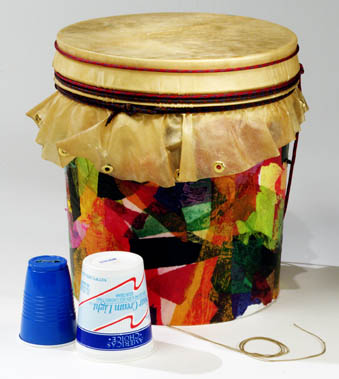This is a series teaching how to make many of the cool sound effects instruments I use in my DrumSongStory programs. I will be updating these posts with video as well. I welcome your photos and videos, links and suggestions. These very simple instruments can also be made as part of a team building process for organizational and corporate groups who are interested in innovative ways to break the ice and build connections and community while having fun.
I’ve also held instrument making workshops just before a performance of Drum Of The Elephant King so that the participants can be an integral part of the show.
Here’s a small audio sample so you can hear how I use these instruments in my DrumSongStory programs:
[display_podcast]
 How to make a “Chicken In A Cup”
How to make a “Chicken In A Cup”
a.k.a. “Friction Drum”, a.k.a. “Guica” (Gwee-ka), a.k.a. “Cuica” (Kwee-kah)
Ages: 6 and up. Younger children may need help from grownups.
Time needed: 10-20 minutes including practice time.
Check out the picture at left. The huge Guica is made out of a 5 gallon paint bucket. I took the bottom out, and stretched a piece of rawhide over it to see if it would make a decent drum. It was only so, so. But there are no failures in this business! I took a piece of waxed linen thread and turned it into a Guica. Now it sounds like an “Elephant In A Cup!” Next to it in the photo are the more usual sized materials.
Materials:
- Plastic cups (the sturdy kind) work the best but you can emphasize recycling by using plastic yogurt containers, or larger plastic sour cream containers. For a very temporary Guica you can use a paper cup. Most kids will rip the bottom out of one of those pretty quick. You can experiment with different sizes and materials.
- Waxed Dental Floss (good) or Waxed Dental Tape (better – but more expensive and smaller amounts available)
- Hammer & Nail: or other tool that will make a decent sized hole in the bottom of a plastic cup.
How To Make It:
- Punch two holes in your plastic container about a finger’s width apart. It helps if your nail is a decent size. It might also be possible to squeeze the cup and snip the holes out with a pair of good quality scissors. Or you could thread a large needle with the Floss and “sew” your floss into the bottom of the cup.
- Take a piece of waxed dental floss about as long as a child’s outstretched arms or one long adult arm and thread each end through a hole.
- Pull the ends through the inside of the cup and make sure they are even.
- Tie a simple knot as close to the holes as possible so the sting doesn’t fall out and so the knot is not in the way of your fingers sliding up and down the string.
- Shazaam! you now have a genuine “Chicken In A Cup”.
Some Tips: When I do large workshops I make the holes in all the cups ahead of time. Making the holes is not a kid activity. And is included here only for adults. I make a charcoal fire in my outdoor grill. I heat up a couple of nails. Using heavy work gloves and a pair of vice grips I grab a hot nail and melt the holes through about 5 cups at a time. Danger: The fumes from the melting plastic are toxic. They also smell nasty. I make sure there is a decent breeze blowing and I hold my breath when necessary. Wearing a protective mask is also a good idea.
I’ve also used an electric drill on a slow setting to drill down through as many as a dozen plastic cups at a time.
How To Play It:
- Hold the cup in one hand and lightly hold the strings in your other hand as close to the cup as possible.
- Then gently slide your hands along the string.
- You should hear an amazingly chicken-like sound. Particularly if you do it in short jerks.
- If you do it in one long smooth pull it sounds more like a sea-gull or maybe a wild animal.
- The larger the cup the bigger the sound.
Some Playing Tips: The sound is created with friction. So, if your hands are greasy or if the wax has been worn off your string by a lot of playing, it might not work as well. In that case wash your hands with soap and water and either get a fresh piece of waxed floss or use a piece of beeswax (available at hobby stores) to re-wax the string. Another technique is to use a small piece of wet sponge. Experiment!
The How To Make Cool Sound Effects Instruments Series:
- How To Be A Shaker Maker
- How To Make A Cuica (a.k.a. Chicken In A Cup)
- How To Make a Rain Stick
- How To Make Wind Tubes
- How To Make An Ocean Drum
- How To Make A 2X4 Xylophone, Old Wrench Xylophone, Wind Chimes etc.
- How to Make A “Paint Stirrer Rhythm Stick”
- How To Make A “Paint Stirrer Stir Drum”
To book one of Mark Shepard’s DrumSongStory programs now, call 1-800-378-4971 or e-mail mark[at]markshepard.com
See what other DrumSongStory Programs are available for: